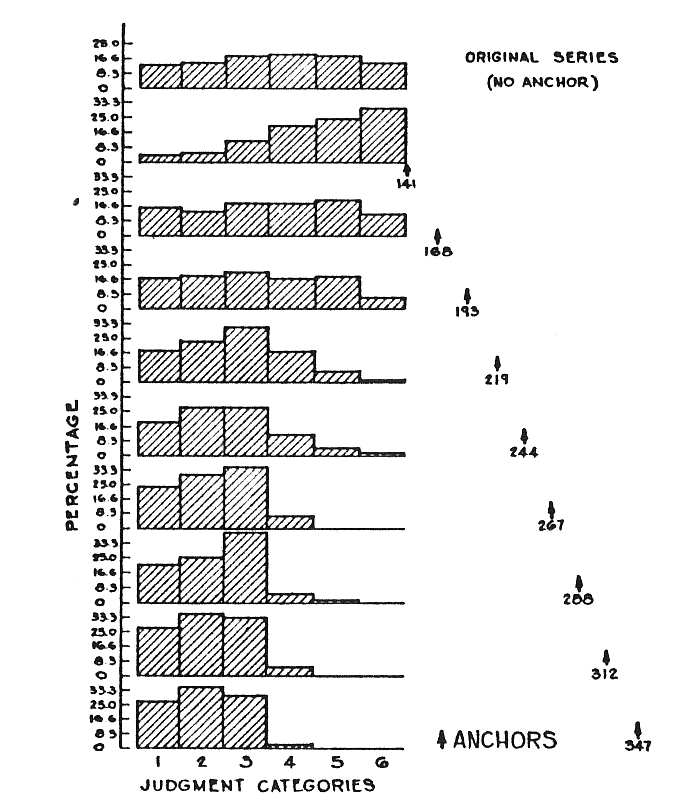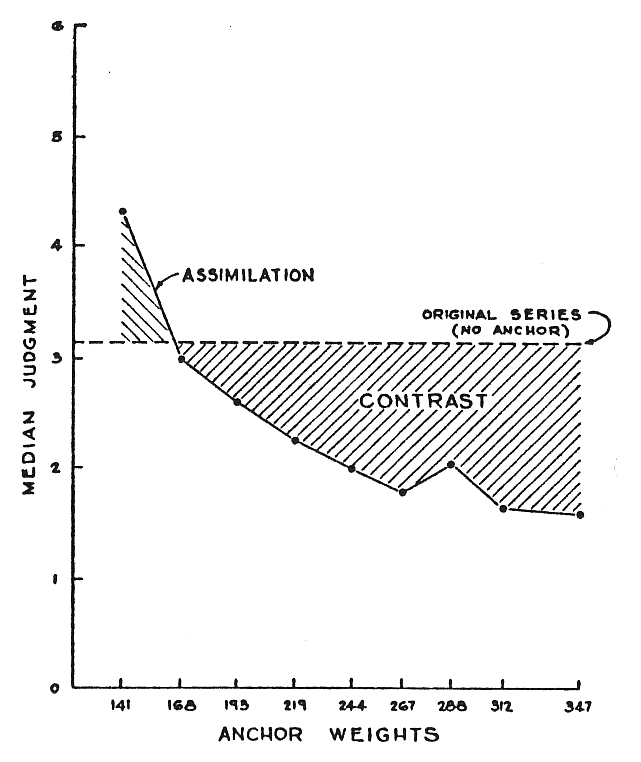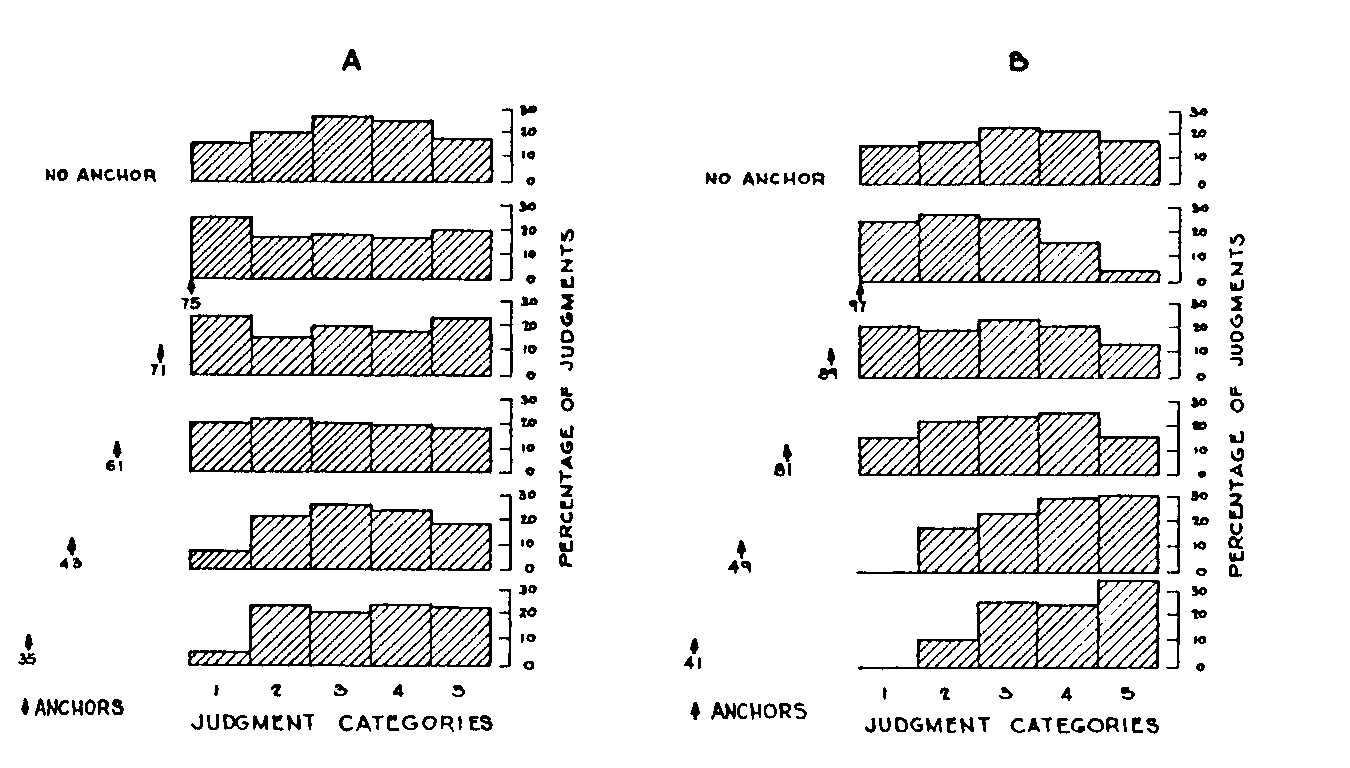Assimilation and contrast effects of anchoring stimuli on judgments.[1]
Muzafer Sherif, Daniel Taub
University of Oklahoma
and
Carl I. Hovland
Yale University
In complex social communication the introduction of reference points may produce two opposing effects. Under some conditions the introduction of a reference point or stand beyond S's current position tends to move him toward the new position. Thus, telling him that experts think it will be at least 10 yr. before peaceful use of atomic power is feasible, may cause an individual to increase his own estimate from one of 5 yr. to one of 6 or 7 yr. Under other conditions the introduction of communication results in a rejection of the new proposal and a stronger entrenchment in his original position. Here one has the frequently mentioned "boomerang effect" (2, 3, 7, 9). To some extent at least, these phenomena may be the result of judgmental processes and may be conceptually closely akin to the phenomena of assimilation and contrast in the judgment of simple stimulus material. Before proceeding to a study of the complex factors involved in communication it was thought desirable to start with an analysis of these judgmental effects with simple stimulus materials in a manner applicable to the social area.
The research of Rogers (11) suggested the feasibility of doing such a study with weight-lifting. Accordingly, the procedures closely paralleled his. Judgments were first obtained as to the categorization of stimuli from 55 to 141 gm. in weight along a 6-point scale, using the method of single stimuli. In the second and subsequent sessions the weights were presented in pairs with the first ("anchor") weight described as being in the topmost category. The anchoring stimuli ranged from 141 to 347 gm. While the procedure was essentially a replication of Rogers' experiment, his formulation was not in the present terms and unfortunately he does not present his data in a form permitting the type of analysis required for the present hypotheses.
The general hypothesis of the study is that whether one obtains an "assimilation effect" or a "contrast effect" depends on the position within or distance from the original series of the introduced anchors (standards). When an anchor is introduced at the end or slightly removed from the end of the series, there will be a displacement of the scale of judgment toward the anchor and assimilation of the new reference point in the series. When, however, the reference point is too remote there will be displacement in the opposite direction (i.e., away from the anchor), with a constriction of the scale to a narrower range.
(151)
More formally, two hypotheses are presented for testing:
1. In judgments of graded stimuli ranging from low to high in some dimension, the introduction of anchors at the end points of the series or immediately above or below the series will cause displacement in the distribution of judgments of series stimuli in the direction of the anchor (assimilation effect).
2. As the anchors are placed at increasing distances from the upper or lower ends of the series, the distribution of judgments will be displaced in the direction away from the anchor and the whole judgmental scale will be constricted (contrast effect).
One or the other of these effects has been suggested by a number of previous experiments (1, 4, 5, 10, 11, 13) but the factor of distance has not been systematically varied to investigate both phenomena in a single study.
PROCEDURE
The basic procedure consisted of obtaining judgments of weight by the method of single stimuli with and without anchoring stimuli. Judgments were made in terms of a 6-point scale, "I" being the lightest, "6" the heaviest. The anchoring stimuli in the main experiment were all equal to or greater than the top stimulus value in the original stimulus series and each was described as a stimulus within the topmost category.
The apparatus consisted of a frame designed to offer sturdy support for the mechanical lifting of a set of weights. The lifting system consisted of light cordage, heavily waxed, placed horizontally over two plastic slide wheels. A horizontal pull upon a handle attached to the cordage provided for an upward motion of the weight attached. Since weight containers were of equal height and the cordage was knotted, pull was of uniform length for the different weights.
The weights were concealed from Ss by a masonite board pierced appropriately to permit passage of the cordage. This procedure of weighing provided few cutaneous cues to S and proved to be a satisfactory procedure for the study. Pretests established that most Ss could comfortably place the stimuli in the series (without introduced anchors) correctly at least 50% of the trials.
The stimulus series consisted of weights of 55, 75, 93, 109, 125 and 141 gm. and is referred to here as the "original stimulus series." The anchoring stimuli were weights of 141, 168, 193, 219, 244, 267, 288, 312 and 347 gm. It will be noted that the 141-gm. anchor is the same as the topmost weight in the original series.
In the first session, the operation of the mechanism was demonstrated by E. Then the following instructions were given: "The stimuli you are to judge will be a series of weights. You are to lift these by pulling up the handle as demonstrated. Following the lifting of a weight you are to judge its location on a scale of I to 6 inclusive. Make a judgment after each lifting even though at first you may not have adequate basis for judgment."
The weights were presented in haphazard order, one by one in sections of 50 presentations with a rest period of 5-10 min. between sections.
Only those Ss who correctly discriminated the original stimulus series in at least 50% of the trials were used in subsequent sessions in which anchors were introduced. Two Ss were not used because they failed to meet this criterion.
In anchor sessions the following instructions were read: "The stimuli will now be presented in pairs instead of singly. The first member of each pair will tell you what you are to call 6, the second you are to judge, as before, on a scale of I to 6. Tell me of your judgment after the second member of each pair even though at first you may not have an adequate basis for judgment."
These instructions were read to S at the beginning of each of the nine anchor sessions. The order in which anchors were introduced in successive sessions was haphazard. Only one anchor weight was used in any one session. No S took part in more than one session on any one day.
Subjects.—The Ss in the main experiment were six male students from the University of Oklahoma. They were naive Ss who did not know the purpose of the experiment and had not previously served as Ss in a psychological experiment. Fach S gave 300 judgments per session and each served in 10 experimental sessions (one with only the original stimulus series and one with each of the nine anchors). Thus, 3000 judgments were obtained from each S.
In addition to the above, extensive pretesting was carried out. In this pretesting phase the
(152) anchor beyond the scale was removed far beyond the highest anchor (viz., 347 gm.) reported in this paper.
RESULTS
 |
| Fig 1. Distribution of judgments for original series of weights without anchors at increasing distances above original series (heaviest anchor at bottom). |
The principal results of the experiment are shown in Fig. 1, where the distribution of judgments of weights is given for the original stimulus series (without anchor) and for the same stimuli when judged with anchors at, or varying distances above, the top stimulus in the series. It will be observed that the distribution of judgments in the original series without anchor is rectangular and does not deviate too greatly from the flat distribution represented by equal frequencies in each category. When an anchor, whose weight in grams corresponds to the top stimulus value in the original stimulus series is used, the result is a displacement of the distribution in the direction of the anchor. Anchors more distant from the top stimulus value in the series tend to produce the opposite effect, causing a displacement of judgments to the lower end of the scale. The effects shown in Fig. 2 hold for each S with only minor variation. These effects can be represented more clearly by plotting the median judgment given to the stimulus series without anchor and with anchors varying distances from the original stimulus series, as in Fig. 2. The median judgment during the original series without anchor is used as the baseline from which to evaluate change.
SUPPLEMENTARY EXPERIMENTS
 |
| Fig.2. Median judgments with anchors at increasing distances from the series (abscissa) plotted against the median judgment without anchor. |
The preceding results indicate the operation of the predicted assimilation and contrast when the anchor is above the series. It seemed desirable to replicate the experiment
(153) to determine whether the effects obtained in the main experiment are also found when anchors are introduced at the lower end of the original stimulus series and at increasing distances from it. This was demonstrated in a supplementary experiment which was carried out in two separate series.
Series 1 [2]
Procedure.—The stimulus series used in the main experiment had to be modified because the remaining range to zero point below the lower end of the original series made the introduction of only a few anchors possible. Accordingly the lightest weight (55 gm.) was eliminated and the series of five remaining weights was used (75, 93, 109, 125 and 141 gm.). Anchors of 75, 71, 67 and 43 and 35 gm. were employed. It will be noted that the first three anchors were close to the series and actually within the original stimulus series used in the main experiment. They were chosen to be maximally sensitive to assimilation effects. The lighter anchors were selected as conducive to contrast with a gap in the region between 67 and 43 gm.
Instructions to Ss were substantially the same as those in the main experiment. The principal procedural difference involved the use of direct lifting of weights in cylindrical containers 9.6 cm. high and 5.5 cm in diameter.
Each S served for six sessions (one original series session without anchor and five anchor sessions) with from 12 hr. to 3 days between sessions. Only one anchor was used during a session. Four different orders of anchors were used for the 4 Ss.
 |
| Fig. 3. Distribution of judgments for two different stimuli series without anchor and with anchors at distances below each series (indicated by arrows). |
Results.—The distributions without anchor and with anchors at varying distances from the series are shown in Fig. 3A. It will be noted that both the 75-gm. anchor and the 71 gm. anchor, which was slightly below the end stimulus, produced shifts in the distribution toward the anchor ("assimilation"). Anchors further removed from the end produced a contrast effect similar to that shown in Fig. 1 although the effects are less pronounced.
Series II [3]
Procedure—Use of the original stimulus series in the main experiment and introduction
(154) of anchors below the series, even as used in the modified procedure in Series I above, posed procedural problems, since too few possible anchors remained below the series and since sensitivity and judgment are atypical in this range (14). So a new series of five Weights was prepared of 97, 118, 137, 153, and 169 gm. The anchors selected were 97, 89, 81, 49 and 41 gm.
In pretests, it Was found that Ss could correctly place the five test stimuli Without anchors at least 50% of the trials. Special note should be made that the highest anchor is identical in value to the lowest stimulus in the original series. Intervals between the three highest anchors were less than half the distance between series stimuli. There Was a gap between these three and the two anchors further removed from the series.
Instructions to Ss were substantially the same as those in the preceding experiments. The principal difference in procedure involved the direct lifting of weights, Which Were in cylindrical containers 8.3 cm. high and 8.5 cm. in diameter.
Each S served for six sessions (one for the original series and one for each anchor) with from 12 hr. to 2 days between sessions. Only one anchor Was used during a session. Three different orders of anchors Were used for the 3 Ss.
Results.—In Fig. 3B the distributions of judgments for the five test weights without anchor and with anchors varying distances removed are presented. It appears quite likely that an assimilation effect occurs in the lower range with the first anchor and the anchor just removed from the series. Anchors further removed resulted in contrast effects much like those obtained in the main experiment. All three Ss show the assimilation and contrast effects indicated for the average.
DISCUSSION
The foregoing results support our hypothesis in showing a range immediately above or below the stimulus series in Which assimilation occurs (assimilation range) and another range beyond this where contrast occurs (contrast range). In the present experiment the assimilation range is rather narrow. We would expect that the range of assimilation would be wider with a greater range of stimuli. On the basis of judgmental relativity we would expect that the range of assimilation would he influenced not only by the absolute distance of the anchor from the extreme stimuli but also by the range of the stimulus series itself. Thus a series from 500-700 gm. would undoubtedly have different assimilation and contrast ranges than a series with the same midpoint (600 gm.) but ranging from 400-800 gm. Thus the effects of scales and anchors are not independent but are reciprocal in their effects.
The present demonstration helps to clarify some of the relationships Which obtain in social judgments. Here We find that an individual places a verbal statement on an issue both in terms of the item's relative proximity to his own position anti the latitude which is acceptable to him around that focal point of acceptance (8). This result is not easily explained in terms of "indifference points" or "neutrality regions" (5, 6). Similarly, in an earlier study (12) we found that a person's position on a social issue serves as the major anchor When he places opinion statements concerning the issue into what he considers the most appropriate number of different categories. The Ss with extreme stands on the issue tended to use very few categories and to utilize some categories with disproportionate frequency, while Ss with middle-of-the-road positions distributed their judgments into a larger number of categories. Here again the displacement of judgments Was related to S's position on the issue, which served as a major anchor.
SUMMARY
The hypothesis was tested that introduction of anchoring stimuli immediately adjacent to the stimuli being judged will cause displacement of judgments in the direction of the anchor. This would constitute an "assimilation effect." Anchors considerably beyond the stimulus range Were also employed to replicate previous findings that this Will produce a displacement of judgments away from the anchor ("contrast effect").
(155) In the first experiment Weights of 55, 75, 93, 109, 125 and 141 gm. Were judged. The anchoring stimuli Were Weights of 141, 168, 193, 219, 244, 267, 288, 312 and 347 gm. In the first session judgments were made without anchors. In subsequent sessions anchors Were introduced before each stimulus being judged. Six male college students gave 300 judgments per session. Clear evidence for the hypothesis was obtained, with pronounced displacement of judgments toward the anchor When it was introduced at the top of the series and displacement away with more distant anchors.
In two further experiments, anchors were introduced at and below the lightest weights in the series. Again anchors at or slightly removed from the stimulus series resulted in displacement of judgments toward the anchor, while anchors more distant from the series produced the familiar displacement away from the anchor.
The relationship of these results to allied phenomena With social judgments is discussed.
REFERENCES
1. BEEBE-CENTER, J. G. Pleasantness and unpleasantness. New York: Van Nostrand, 1932.
2. COOPER, E., & JAHODA, M. The evasion of propaganda: how prejudiced people respond to anti-prejudice propaganda. J. Psychol., 1947, 23, 15-25.
3. FLOWERMAN, S. H. The use of propaganda to reduce prejudice: a refutation. Internat. J. Opinion & Attit. Res., 1949, 3, 99-108.
4. HEINTZ, R. K. The effect of remote anchoring points upon the judgment of lifted weights. J. exp. Psychol., 1950, 40, 584-591.
5. HELSON, H. Adaptation-level as frame of reference for prediction of psychophysical data. Amer. J. Psychol., 1947, 60, 1-29.
6. HELSON, H. Adaptation-level as a basis for a quantitative theory of frames of reference. Psychol. Rev., 1948, 55, 297313.
7. HOVLAND, C. I., JANIS, I. L., & KELLEY, H. H. Communication and persuasion. New Haven: Yale Univer. Press, 1953.
8. HOVLAND, C. I., & SHERIF, M. Assimilation and contrast effects in reactions to communication and attitude change. J. abnorm. soc. Psychol., 1957, 55, 244252.
9. LAZARSFELD, P. F. Communication research and the social psychologist. In W. Dennis, (Ed.), Current trends in social psychology. Pittsburgh: Univer. of Pittsburgh Press, 1948, 218-273.
10. LONG, L. A study of the effect of preceding stimuli upon the judgment of auditory intensities. Arch. Psychol., 1937, No. 209.
11. ROGERS, S. The anchoring of absolute judgments. Arch. Psychol., 1941, No. 261.
12. SHERIF, M., & HOVLAND, C. I. Judgmental phenomena and scales of attitude measurement: placement of items with individual choice of number of categories. J. abnorm. soc. Psycho!., 1953, 48, 135141.
13. VOLKMANN, J. The anchoring of absolute scales. Psychol. Bull., 1936, 33, 742-743. (Abstract)
14. WOODWORTH, R. S. Experimental psychology. New York: Holt, 1938.